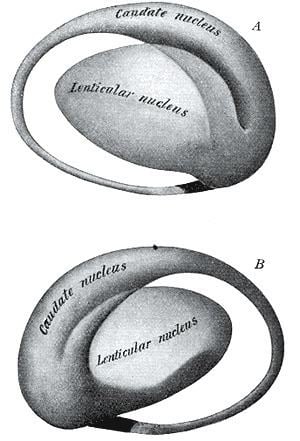Latin nucleus lentiformis TA A14.1.09.506 | NeuroNames ancil-253 FMA 77615 | |
 | ||
MeSH A08.186.211.730.885.105.487 | ||
The lentiform nucleus or lenticular nucleus comprises the putamen and the globus pallidus within the basal ganglia. It is a large, lens-shaped mass of gray matter just lateral to the internal capsule.
Contents
Structure
When divided horizontally, it exhibits, to some extent, the appearance of a biconvex lens, while a coronal section of its central part presents a somewhat triangular outline.
It is shorter than the caudate nucleus and does not extend as far forward.
Boundaries
It is lateral to the caudate nucleus and thalamus, and is seen only in sections of the hemisphere.
It is bounded laterally by a lamina of white substance called the external capsule, and lateral to this is a thin layer of gray substance termed the claustrum.
Its anterior end is continuous with the lower part of the head of the caudate nucleus and with the anterior perforated substance.
Components
In a coronal section through the middle of the lentiform nucleus, two medullary laminae are seen dividing it into three parts.
The lateral and largest part is of a reddish color, and is known as the putamen, while the medial and intermediate are of a yellowish tint, and together constitute the globus pallidus; all three are marked by fine radiating white fibers, which are most distinct in the putamen.
Etymology
The name comes from Latin and means lens-shaped, probably referring to the appearance of the nucleus from the side.
